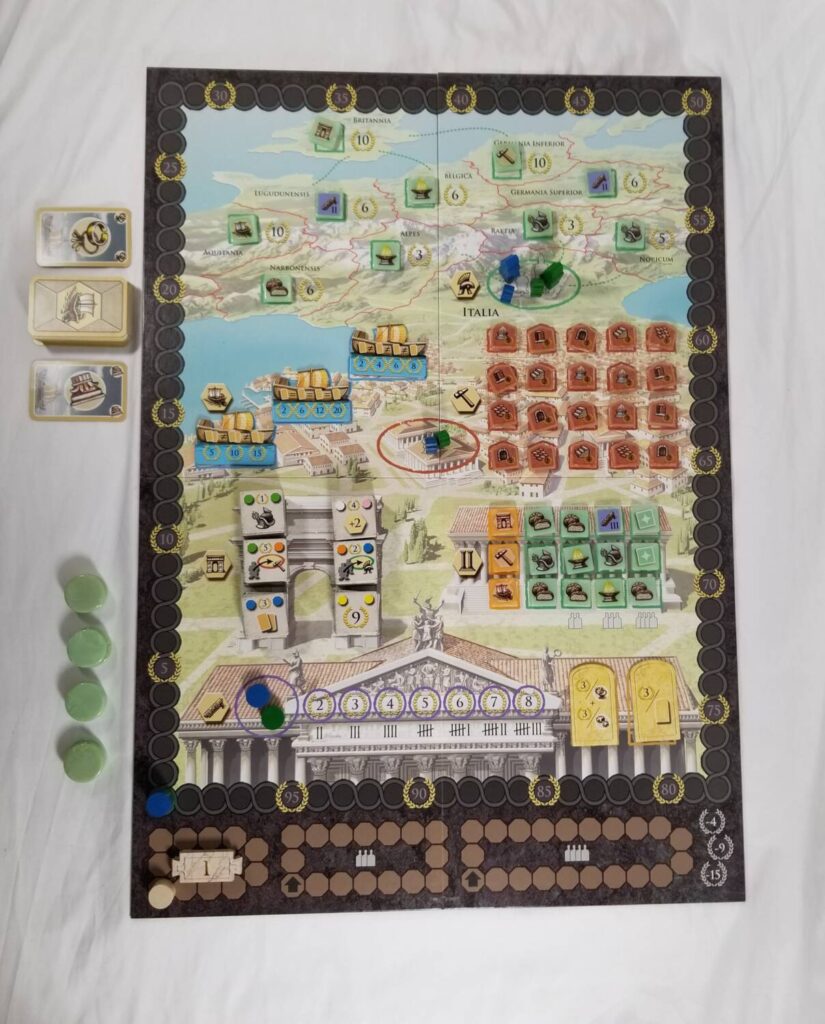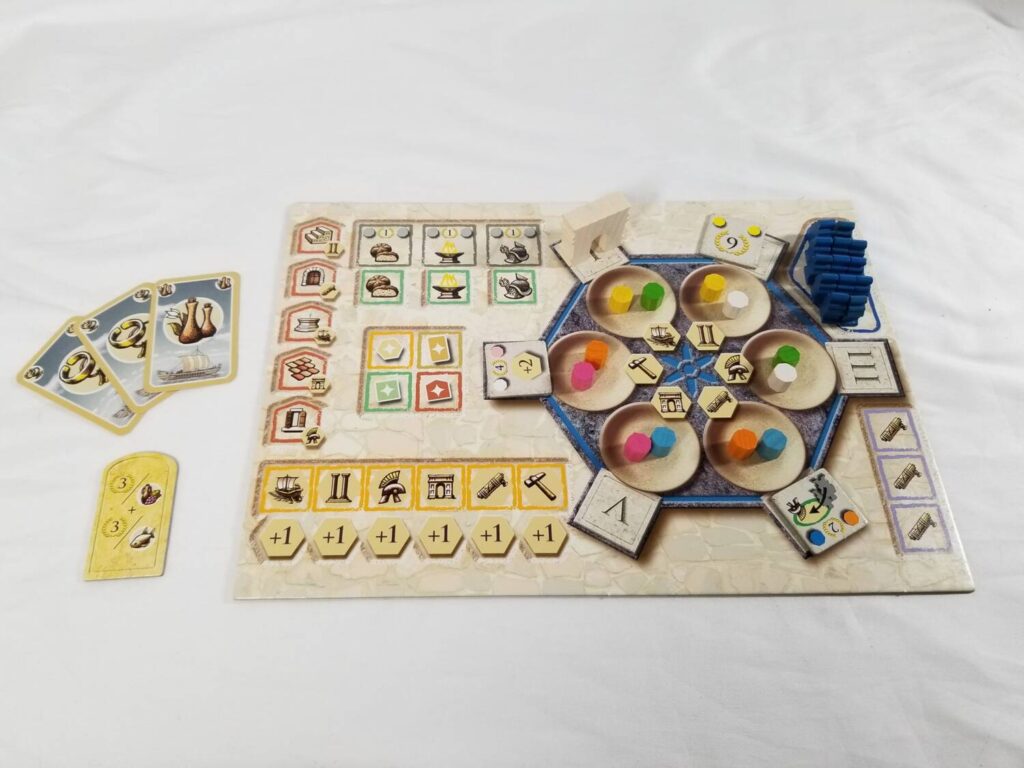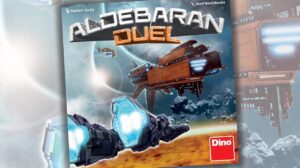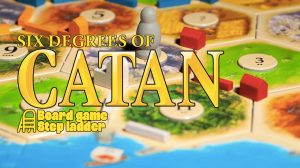Hello and welcome to ‘Focused on Feld’. In my Focused on Feld series of reviews, I am working my way through Stefan Feld’s entire catalogue. Over the years, I have hunted down and collected every title he has ever put out. Needless to say, I’m a fan of his work. I’m such a fan, in fact, that when I noticed there were no active Stefan Feld fan groups on Facebook, I created one of my own.
Today we’re going to talk about 2011’s Trajan, his 15th game.
2011 was a busy, and career defining, year for Stefan Feld. Earlier that year, he’d released Strasbourg. Even earlier than that, the unassuming The Castles of Burgundy had appeared on the boardgaming scene, completely unaware of the mark in history it was going to make. If Feld had been flying under the radar, he certainly wasn’t anymore. The Castles of Burgundy took the world by storm, placing Stefan Feld squarely in the spotlight. It was a game that marked him as a designer to watch out for. And Trajan only served to solidify that status, proving that it is possible to catch lightning in a bottle a second time.
Overview
Using Ancient Rome as a backdrop, Trajan is a game that challenges players to maximize what little time they have to outsmart, and hopefully outscore, their opponents. At the heart of the game is a mancala mechanism called the Action circle.
At the beginning of the game, the Action circle is seeded with twelve colored cylinders (six pairs of six different colors). On a player’s turn, they will pick up a group of cylinders and move along the Action circle in a clockwise fashion, depositing one cylinder into each action space they pass. The location where the final cylinder is deposited determines the actions that the player can perform. There are territories to be conquered, buildings to build, senators to influence, goods to be collected and shipped, and others. Virtually every action taken in the game will result in the gaining of sweet, sweet victory points.
This Action circle movement also functions as a sort of game timer. The game lasts for four rounds, the length of which is represented by a track that is divided into a number of segments, dependent on player count. On the track is a marker that moves a number of spaces equal to however many spaces along the Action a circle a player moves on their turn. The more they move around the Action circle, the faster the round will come to an end. When the round ends, there are some bonuses that will be awarded before the next round begins, and at the end of the fourth round, the person with the most points will win.
Of course, this is a very high-level overview of the game. If you think you’ve heard enough and just want to know what I think, feel free to skip ahead to the Thoughts section. Otherwise, read on as we learn how to play Trajan.
Setup
A game of Trajan is set up thusly:

Place the main board in the center of the table. At the northern edge of the board is the military area. Each of the provinces in this area is populated with a random Forum tile. Beneath this are the seaport (on the left) and the construction district (on the right). The shipping lanes are populated with the three Ship tiles (color side face up). The construction district is populated with randomly placed Construction tiles.
Beneath this is the Arch of Trajan area (on the left) and the forum (on the right). The Trajan tiles are arranged into shuffled stacks, by type, and placed face up on top of the Arch of Trajan. The forum is populated with randomly drawn Forum tiles and Extra Action tiles. Beneath this is the senate track. Two randomly drawn Bonus tiles are placed into the marked locations at the end of the track.
A stack of shuffled, face down Demand tiles is created and placed next to the board along with the +2 Tiles, the Quarter Year tiles, as well as the leftover Extra Action and Forum tiles. The deck of Resource cards is shuffled and placed facedown. Then, two cards are drawn from the top and placed to the right and left of the deck to form two faceup discard piles. The Time marker is placed onto the first space of the time track for the current player count. Then, the players receive their player-specific items.

Each player chooses a color and receives a player board, all their wooden pieces, an Arch of Trajan, and a collection of Action markers (six colors, two copies of each). The Arch of Trajan begins on the Roman numeral I. Each of the source trays is randomly seeded with two Action markers apiece.
Next, player order is determined. In order, each player places their Military leader and a small worker into the military camp, a small worker into the worker camp, a marker onto the first space of the senate track, and a marker onto the score track. In player order, each player receives a Bonus tile from the bag, three Trajan tiles of their choice (placed onto the II, IV, and VI spaces on their player boards), and three cards from the Commodity deck (taken from the discard piles, off the top of the deck, or some combination thereof). The remainder of their small workers are placed on their player board in the area at the top right.
Now, you’re ready to begin playing Trajan.
On Your Turn…
…you’ll choose a group of Action markers on one of your source trays, pick them up, and move a number of spaces clockwise equal to the number of Action markers you picked up (depositing a marker into each source tray you pass over). If there’s a Trajan tile next to the source tray in which you placed your final marker, you may complete that tile as long as you meet the requirements. For instance, if the Trajan tile depicts a blue and pink marker, you’d need to have at least a blue and pink marker in the source tray to complete it.
Trajan tiles reward you with various things such as extra cards, extra actions, or straight up victory points. There are even some that reward you with Extra Action doublers. I mentioned Extra Action tiles during setup. These tiles are associated with the six areas of the game board—military, seaport, construction, Trajan, forum, and senate—and can be discarded, after performing an action, to perform the associated action a second time. The doubler will allow you to perform that action yet again. I’ll go into more detail about what can be done in these various locations shortly.
After having completed the Trajan tile (if able), you may then optionally perform the action associated with the source tray on which you ended your turn. There are six source trays and each is associated with one of the locations on the board.

The Time marker moves along the time track, clockwise, a number of spaces equal to the number of Action markers you picked up. If this causes the Time marker to land on or move beyond the starting space, it will trigger the end of a round. We’ll talk about that when we talk about scoring.
The Actions
Without getting too far into the weeds, here’s a brief overview of the six different actions.
Military: This action allows you to send a small worker to the military camp OR move your Military leader from one province to an adjacent province (collecting the Bonus token if it’s still there) OR move a small worker from the military camp to join their Military leader (to score points).
Seaport: This action allows you to draw new Commodity cards OR play Commodity cards into your tableau (this is important for scoring) OR discard Commodity cards to make deliveries to the Ship tiles to score points.

Construction: This action allows you to move a small worker to the worker camp OR move a worker from the worker camp onto a building site and collect the tile that’s there, if there is one, in order to score immediate points and to set yourself up for end-of-game set collection points as well.
Trajan: This action allows you to take one of the face up Trajan tiles and add it to your player board wherever the Arch of Trajan currently resides. Then the Arch slides into the next empty slot.
Forum: This action allows you to gain a Forum tile and add it to your player board. These come in different flavors ranging from the Extra Action tiles, described earlier, to temporary Senate and Demand fulfillment tiles, to joker tiles, which can stand in for just about any other tile. I’ll talk about the senate and demands when I talk about scoring.
Senate: This action allows you to advance your marker along the Senate track one space, scoring the points shown on the space where you end up. If another player’s marker is already there, yours is placed on top of theirs.
Wrapping Up
After the Time marker makes one complete circuit around the time track, a Demand tile is revealed. Once the third Demand tile is revealed in this way, the players continue playing until the Time marker makes its fourth transversal. At that time, the current quarter year comes to an end and some interim scoring is performed. The game ends after the fourth quarter. After the game round scoring is performed for that quarter, a final scoring is performed. The person with the most points wins.
Each Demand tile features one of three icons. Players must either pay these icons by discarding matching Forum tiles, displaying the icons on collected Trajan tiles, or some mixture of both to avoid taking negative victory point penalties. The more icons you’re unable to come up with, the harsher the penalty. After the Demand tile fulfillment, the senate votes are tabulated to determine who has the most. There are some Forum tiles that provide temporary votes. These are added to the votes provided by where each player sits on the Senate track. The winner gets their choice of the two Bonus tiles. The second place winner gets the other, flipped to its grey side, which is worth fewer points. Then, a board reset is performed and a new round begins (unless this was the last round).
During final scoring, workers left in the camps, claimed Trajan tiles, and leftover cards are worth a point each. Points are scored for having matched sets of Construction tiles, the bigger the set, the more points the set is worth. Bonus tiles also score.
Thoughts
Prior to playing Trajan for the first time, the only other Stefan Feld titles I’d played were Bora Bora and The Castles of Burgundy. To say that Trajan was a step up in complexity would be an understatement. Trajan still stands out (at least to me) as one of Feld’s most (if not the most) complex titles. I’d stepped off of the kiddie pool ledge and immediately found myself floundering in the deep end. It isn’t that any of Trajan’s mechanics or concepts are particularly hard to grasp. The mancala mechanic, while being used in a very novel way, is nothing new. Mancala has been around for a very long time. There’s nothing new about sending workers out to specific locations or collecting sets of things to score points. It’s all been done before. But, what Stefan Feld excels at, and with Trajan specifically, is asking you to consider all of those things at the exact same time within the exact same framework.
Trajan requires a lot of on-the-fly thinking, but it also asks you to carefully plan for the future. Every mancala-style Action marker drop is a set up for another turn. Those turns are set ups for other turns in themselves. To top it all off, you’re always playing against the clock. There’s always the risk that your opponents will run down the clock while you’re trying to get set up for a high-scoring move.

It’s all pretty brilliant how it comes together. It’s also completely devoid of any kind of theme. If the awesome artwork on the front of the box drew you in and had you thinking you were about to get immersed into the world of Ancient Rome, think again. While the game might feature a map of the area and some Roman numerals scattered about, you’ll never quite feel like you’re in the thick of it. And that’s okay. Trajan’s interesting gameplay is more than enough to make up for the thematic deficit.
It’s because of that that it became an instant favorite of mine. All these years later, that hasn’t changed. Even in the current board game landscape, Trajan still stands out as one of the better games out there. For years, it sat atop my list of favorite Felds until it was dethroned by The Oracle of Delphi. As time has gone by and Feld has released more games, it’s gotten pushed further down the list, but it’s still up there pretty high.
If you don’t own Trajan, it’s a must have for any Feld collection. Even if you’re not a Feld junkie, you won’t regret the purchase. While it may not be Feld’s greatest game ever, it’s still a pretty great game.











Add Comment